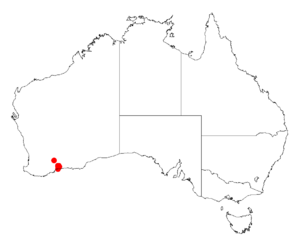Acacia pusilla facts for kids
Quick facts for kids Acacia pusilla |
|
|---|---|
| Scientific classification | |
| Genus: |
Acacia
|
| Species: |
pusilla
|
 |
|
| Occurrence data from AVH | |
Acacia pusilla is a small, dome-shaped shrub. It belongs to the Acacia family, which is a large group of plants often called wattles. This special plant is found only in the southwestern part of Australia. When a plant or animal is found only in one specific area, it is called endemic.
About the Plant
This shrub usually grows to be quite small. It reaches a height of about 0.1 to 0.3 meters (which is about 4 inches to 1 foot). Its branches are decumbent, meaning they lie along the ground. They are also covered in fine hairs.
Leaves and Flowers
Like most Acacia species, Acacia pusilla does not have true leaves. Instead, it has phyllodes. These are flattened leaf stalks that look and act like leaves. The phyllodes of Acacia pusilla are crowded together and are a grey-green color. They are also glabrous, which means they are smooth and hairless.
These phyllodes are narrow and flat, about 5 to 13 millimeters long (about 0.2 to 0.5 inches). They are only about 1 millimeter wide. The plant also has small, pointed structures called stipules at the base of its phyllodes. These stipules are persistent, meaning they stay on the plant. They are also setaceous (bristle-like) and recurved (curved backward).
Acacia pusilla produces bright yellow flowers. It blooms during the months of September and October.
How it was Named
The plant Acacia pusilla was first officially described by a botanist named Bruce Maslin. A botanist is a scientist who studies plants. Maslin wrote about this plant in 1999. His work was published in a science journal called Nuytsia. The full title of his work was The taxonomy of fifty-five species of Acacia, primarily Western Australian, in section Phyllodineae.
Later, in 2003, another botanist named Leslie Pedley reclassified the plant. He gave it a new name, Racosperma pusillum. However, in 2014, it was moved back to the Acacia group.
Acacia pusilla is closely related to another plant called Acacia rhamphophylla. It also looks similar to Acacia lachnophylla.
Where it Grows
This unique shrub is found along the south coast of Western Australia. It grows in the Goldfields-Esperance region. You can find it from the area around Esperance in the west to Israelite Bay in the east.
It often grows near the edges of salt lakes and on sandplains. It prefers sandy-clay soils, especially where there is limestone nearby. Most of these plants are found in the Ravensthorpe Range. Here, they grow on the lower slopes, often near watercourses. They are part of dense mallee shrub and woodland communities. Mallee refers to a type of plant growth where many stems grow from a single underground rootstock.

